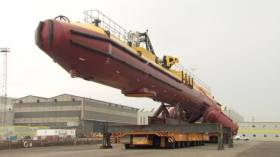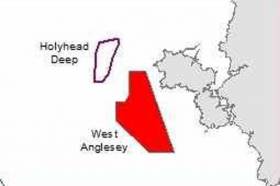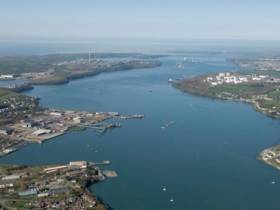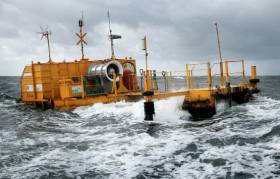Displaying items by tag: Power from the Sea
#WorldsLargest - The world's most powerful tidal energy turbine writes the BBC News was assembled at Harland and Wolff shipyard in Belfast.
One of the yard's cranes, Goliath, will lower the 520-tonne structure into Belfast Lough today, Wednesday.
Each of the its twin rotor arms produces 1 megawatt of energy - enough to power thousands of homes when connected to the electricity grid.
After trials in the lough, the turbine will be used off the Orkney Islands.
The 75-metre long structure has taken a year to put together.
It will float on the water with the rotors dropped below the surface.
Plans For Tidal Energy off Anglesey Move A Step Forward
#TidalEnergy - An underwater turbine scheme off Anglesey, north Wales, will help power up to 25,000 homes, reports The Daily Post.
The scheme would create one of the most sought after tidal energy sites in the world, has received a £300,000 boost.
The cash injection is a major step forward in the process to introduce a number of tidal devices, each producing up to 30 megawatts, over a 35 sq km zone, with hopes the first turbines could enter the water in two year’s time.
The Morlais Tidal Energy Demonstration Zone, which has sparked interest from across the globe, was selected for its tidal energy resource and access to infrastructure such as Holyhead Port and potential National Grid connections to accommodate the Wylfa Newydd nuclear plant .
But in order to fund the £30m project EU bids need finalising.
Now the plans have been handed an early boost with a £300,000 donation from Magnox’s Socio-economic scheme, delivered by the Nuclear Decommissioning Authority.
For more on the scheme, click here including separate plans for 'underwater' kites.
Port Based Marine Power Device Cements Innovation Partnership
#PortWaveSub - An agreement between Marine Power Systems (MPS) following testing of key components of a pioneering wave powered renewable energy technology at Pembroke Port has been signed with the facility’s operator, the Port of Milford Haven.
The pump that is central to the concept of a pioneering WaveSub wave energy converter was tested in an onshore tidal lagoon at Pembroke Port. The pump will form part of the quarter size prototype that is now being developed by Swansea-based MPS. The WaveSub project has been part-funded by the European Regional Development Fund through the Welsh Government, with MPS receiving a £2 million grant in October 2015.
In a Memorandum of Understanding between MPS and the Port of Milford Haven, this will see deeper cooperation in WaveSub’s ongoing development. Wave energy is thought to hold great promise for delivering abundant renewable energy from the sea off the coast of Pembrokeshire and globally.
Due to the patent protected innovations of the WaveSub, it can be manufactured at commercial scale from a single facility in Wales and deployed throughout Europe.
Chief Executive of the Port of Milford Haven, Alec Don said, “Supporting companies with skills in the development of technologies and Intellectual Property is central to the Port’s strategy to promote a thriving marine renewable energy industry in the region.
“It’s great news to see Marine Power Systems go ahead with development of the WaveSub. It is just a few short months since Tidal Energy Ltd deployed their DeltaStream device, built here on the dockside, in the waters off the coast. Once again we are firmly committed to providing business support and help in kind and will be introducing MPS to some of the highly skilled companies the local supply chain can undoubtedly provide.”
Dr Gareth Stockman, co-founder and managing director of Marine Power Systems, said, “Marine Power Systems is hugely grateful to the Port of Milford Haven for its support. It has recently helped with the deployment and installation of the pump and it is great to know that they will be able to provide further assistance whilst manufacturing & deploying our ¼ scale prototype.”
#PowerFromTheSea - Ireland could be central to the mainstreaming of ocean energy over the next 35 years, according to a new report from the emerging industry.
As The Irish Times reports, the Marine Renewables Industry Association (MRIA) maintains a healthy outlook for the development of wave and tidal energy projects despite revising its predictions for the next decade.
Though "technical challenges" remain in offshore renewables for both wave and wind power generation, Ireland has been marked for "generally strong" policy in the area – and has been encouraged to work with Scotland towards closing the funding gap between research and commercial application.
That view chimes with news from the Maritime Journal, which says Ireland's marine energy market could be worth €15 billion by 2050.
Singled out for its significant contributions in the sector is the SFI Research Centre, Marine Renewable Energy Ireland (MaREI) at University College Cork (UCC), which also houses the Lir National Ocean Test Facility.
That's one of a number of Irish 'innovation hubs' involved in exploring the potential benefits of ocean energy, as previously reported on Afloat.ie – and as discussed at the recent symposium of marine energy leaders in Cork.
Marine Journal has much more on the story HERE.
Launch of World’s Largest 3D Wind Map Technology in Dublin Bay
#3DwindMaps -The world’s largest trial of scanning Light Detection and Ranging (LiDAR) technology by Carbon Trust is taking place on Dublin Bay. This is the latest Offshore Wind Accelerator (OWA) project designed to help reduce the cost of energy from offshore wind.
Over the next three months the most comprehensive test of scanning LIDAR technology will take place, where four different scanning LiDAR systems will be put through their paces, alongside three vertical profiling LiDARs for validation purposes. The project is being supported by independent renewable energy company, RES and maritime safety organisation, Commissioners of Irish Lights.
Accurate wind resource measurements are critical to wind farm development because they are used to calculate the potential energy yield from a wind farm, which dictates the terms of the project financing. This can be a significant proportion of the overall project cost, accounting for around 45 percent for an average wind farm.
Scanning LiDAR is not a new technology. Conventionally, it is used by the defence and aerospace industries to monitor for oncoming weather fronts. But it does not have a proven track record in offshore wind.
Normally wind resource is measured using large steel towers called met masts, which require a large capital investment (£10-£12m) incurred at risk before a project gets the go ahead adding significant upfront costs, which could inhibit the exploration of new sites. The OWA project aims to test how accurately scanning LiDAR technology can measure wind resource for potential wind farm sites, which could deliver significant cost savings in the early stages of wind farm development.
The OWA has been working for the past few years to support more cost effective solutions, focusing on the development and commercialisation of a number of floating LiDAR systems, to significantly reduce upfront capital expenditure. Yet measurements taken by both masts and floating LiDAR are limited in that they only provide a measurement of the wind resource at a single point in space. For an offshore wind farm covering an area of up to 200 square kilometres, this can create uncertainty on the wind speed at locations far from the measurement point. This is known as spatial variation, where measurements may not representative of the entire site. This is translated into risk incurring additional financing costs to wind farm development.
Scanning LiDAR technology has the potential to reduce the risk associated with spatial variation. These systems are capable of scanning with a usable range of between 10 to 30 kilometres, to impressive levels of detail, taking over 100 measurements per minute. This allows developers to build a much more detailed picture of a site, not only significantly reducing uncertainty of spatial variation, but also allowing developers to better plan the layouts of the turbines to best exploit the individual wind conditions at the site. Increasing confidence on spatial variation could reduce risk to minimal levels, which can save millions of pounds on a project and reduce the cost of energy from offshore wind.
A difference of only 0.2 mph in wind speed can result in significant variation of yield calculations over the lifetime of a wind farm. It is therefore critical that the industry has confidence in scanning LiDAR devices being sensitive enough to detect such small variations. The OWA trial aims to test the sensitivity of the devices to picking up these variations in wind resource.
Welsh Ports Report Positive Growth Handling 12.5m Tonnes
#WelshPorts – A network of five Associated British Ports (ABP) in South Wales including the Port of Swansea (see report on former ferry operator) had handled more than 12.5 million tonnes of cargo from the region in 2015.
In addition, the port’s launched an array of renewable energy projects and significant new investments.
The 12.5 million tonnes of cargo that passed through the ports included a variety of both traditional and emerging sectors. The import and export of steel remains strong at the ports with Newport holding the title of the UK’s second largest steel handling port.
Sectors that have seen the most growth include the animal feed and fertiliser industry which has seen the ports adapt to accommodate these businesses and support local agriculture. The timber sector also generated noteworthy volumes of cargo.
The Port of Swansea also showcased its versatility and skills with the handling of wind turbine components for the Pen y Cymoedd wind energy project that will continue until spring of this year. On completion, this is due to be the biggest onshore wind farm in Wales and England.
A series of renewable energy projects has seen the ports move towards further energy self-sufficiency. Heavy investment has resulted in several wind and solar projects that collectively generated 7.8 million units of electricity in 2015.
Projects include the 4.5MWp Barry solar array that was commissioned in August 2015 and officially opened by Alun Cairns MP and Jane Hutt AM. The solar project was the result of an investment of over £5 million by ABP.
Further electricity was generated by the 2.3MW wind turbine at the port of Newport, and a series of 250kW rooftop solar projects. The ports are also currently trialling the use of electric vehicles.
These projects serve to reduce the amount of carbon emissions produced by the ports with the energy generated used to power port operations. Any surplus energy is then exported to the national grid.
An additional £4 million was invested in new cargo handling equipment and operational equipment at the ports, including the purchase of a Mobile Harbour Crane and the installation of a new fertiliser bagging line at the Port of Swansea.
This growth has resulted in the permanent workforce at the ports increasing. The operations department has grown by 10% to accommodate customer demand.
As well as welcoming a wide variety of businesses through the lock gates, the ports also serve as a hub for many customers due to their strong network of transport links via road, rail, and sea.
In April 2015 Travis Perkins opened a major distribution centre at ABP Cardiff which represented an investment of £5 million by ABP. This facility resulted in the creation of 100 jobs and is a great example of what ABP’s unique logistical network of ports in South Wales can offer customers.
ABP Director South Wales, Matthew Kennerley, is pleased with the developments across the five ports over the past year.
He said: “Investments throughout 2015 have allowed us to further develop a service tailored to our customer’s needs. The ports continue to be a thriving and unique landscape where businesses can grow and generate strong trade links. We have further investments planned for 2016 that encompass a wide range of port activity.
“The result of ABP’s South Wales operations is an annual contribution of almost £1 billion to the Welsh economy. The vast assortment of businesses that use the ports also means that 15,000 Welsh jobs are supported by them along with an additional 6,000 supported in the rest of the UK.”
Tidal Energy Turbine to Be Removed from Strangford Lough
#TurbineToGo - A tidal energy turbine is to be removed from Strangford Lough, Co. Down, reports BBC News.
The SeaGen turbine was lowered into place in 2008 (see report photo) and generates electricity from tidal currents.
Two horizontal axis turbines are anchored to the seabed and are driven by the powerful currents resulting from the tide moving in and out.
Its owners Atlantis Resources (only since July, 2015) said it will be decommissioned later this year.
The company said it had been "an essential research and design platform".
Stephen Ward, the firm's director of power generation, said: "This year, we will embark on the next stage of the R&D (research and development) process and focus on decommissioning the SeaGen device.
"This operation will be the first commercial scale turbine development to be decommissioned and will help us to understand the complete life-cycle of a tidal stream development."
Production Storage Boat for Tullow Oil Heads for Ghana
#NewOilboat -A new floating production, storage and off-loading (FPSO) vessel, which will produce and store oil coming from Tullow Oil’ s Tweneboa-Enyenra-Ntomme (Ten) offshore oil fields, according to The Irish Times set off for Ghana last weekend.
The massive FPSO (for photo, click link to newspaper) has been under construction in Singapore since October 2013. The boat’s on-schedule departure is an important milestone for the Ten Project which is over 80 per cent complete and on track to start producing oil this July or August.
The FPSO has a nominal production capacity of 80,000 barrels of oil a day and a capacity of 1.7 million barrels. She is 350m long and can accommodate 120 people. The FPSO is expected to arrive in Ghanaian waters in March. She will be stationed above the Ten fields, around 60km from the coast of west Ghana.
Tullow has an interest of just over 47 per cent in the oilfield offshore Ghana.
Apple Invests In Galway Bay Ocean Energy Research
#MarineScience - Apple's latest investment will mean more than a jobs boost as the technology giant has also committed to marine energy prototypes at Galway Bay's 'ocean observatory'.
Yesterday (Wednesday 11 November) Apple announced an expansion of its Cork campus to increase its staff by 1,000 by mid 2017, according to RTÉ News.
But hidden in the headlines was news that the company has signed a memorandum of understanding with the Sustainable Energy Authority of Ireland (SEAI) to assist its grant recipients on marine research and development.
As renewable energy site reNews reports, Apple is providing a total of €1 million – €250,000 a year over four years starting in 2016 – to help ocean energy start-ups put their devices through their paces at the Galway Bay Ocean Energy Test Site.
Apple's vice president of environment, policy and social initiatives Lisa Jackson said the company is "excited by the potential of ocean energy to someday serve as a source of clean power for the data centre we are building in Athenry."
reNEWS has more on the story HERE.
Floating Windfarm For Scottish Waters
#Windfarm - Scotland is set to host the first floating offshore windfarm in British and Irish waters, as the Guardian reports.
Backed by Norwegian energy giant Statoil, the Hywind Scotland project will comprise five 6MW turbines interconnected by cables and anchored to the seabed, generating energy to power as many as 20,000 homes.
Construction is set to begin off mainland Scotland's easternmost point at Peterhead in the new year, and is expected to see reduced generating costs well below £100MWh.
It's also hoped that the pioneering scheme will lead to the use of more remote and deeper water sites for the windfarms of the future.
The Guardian has more on the story HERE.

































































